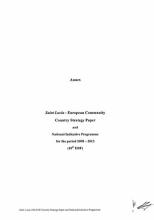

The purpose of this Country Support Strategy is to provide a framework for EU assistance programmes in Saint Lucia under the 10th EDF. It outlines the current status of the EU–Saint Lucia relations, elaborates a detailed country diagnosis, summarises the Government’s development agenda, reviews the past and present cooperation with the EC and the activities of other major donors, and concludes with the proposed EU response strategy and its corresponding indicative work programme.
Saint Lucia, one of the four Windward Islands, is a small lower-mid-income economy with an area of 620 sq km and 158 km of coastline; a population of 168,400 (2006 estimate); and an estimated GDP of EUR 608 456 094 (USD 925 000 000) and GDP per capita of EUR 3 648 (USD 5 546) (both figures for 2006 at current market prices). Saint Lucia is a well-established parliamentary democracy with universal suffrage, free elections, a multiparty structure, equality of access to political activity and participative decision-making. Saint Lucia achieved independence from the UK in 1979. The chief of state is Queen Elizabeth II as represented by a Governor General. The Prime Minister, the Hon. Stephenson King, was sworn into office in September 2007. Saint Lucia is a member of the Organisation of Eastern Caribbean States (OECS), the Caribbean Community (CARICOM) and the Association of Caribbean States (ACS). Its economy is traditionally agriculture-based (bananas and other crops), but with a growing services sector centred on tourism, and a manufacturing sector which is showing relative growth. It is a small island developing state (SIDS) with all the inherent challenges such as a narrow economic base and a high vulnerability to external shocks and natural disasters. The country enjoys a relatively high index of human development (0.795 in 2005) as social indicators are relatively good. (According to the UNDP Human Development Report in 2007, Saint Lucia was ranked 72 out of 177 countries). However, there are also considerable social gaps and deficiencies, one of the most important being a high level of poverty linked to a high unemployment rate.
The Government’s Strategy over the medium term (2006-2011) will concentrate on the need to exploit all opportunities for sustained growth and development and to restructure and reposition the economy for successful integration within an increasingly liberalized regional and international trading environment, in particular the CARICOM Single Market and Economy (CSME) and the OECS Economic Union. The key priorities of the Government’s development strategy are to halt any further decline in the agricultural sector and encourage agriculture and wider economic diversification; provide the enabling environment to foster a private sector-led growth, notably to boost tourism activity with a deliberate emphasis on increasing returns to the local economy through effective linkages; encourage education and human resource development; support the emerging informatics industry and financial services sector, and also encourage the adoption of appropriate technology as a means for achieving greater efficiency.
The EC aid provided to Saint Lucia since 1975 is estimated at EUR 150 000 000. The biggest share has come through the Stabex and SFA mechanisms, which is equivalent to almost three times the amount of the NIPs, and is used to expedite the ongoing restructuring of the banana sector and to support economic diversification. The 7th, 8th and 9th EDF focused on health, namely the building of a new hospital which is due to start in early 2009.
The EC and the Government hereby propose to allocate 85% of the “A Envelope” under the 10th EDF to Private Sector Development to assist the Government with the implementation of policies and strategies aimed at achieving private sector-led growth. Approximately 7.5% of the “A Envelope” will be allocated to the Technical Cooperation Facility, including to support Non-State Actors. The remaining 7.5% will be allocated to Technical Assistance to the NAO Office and other key line Ministries.
| Attachment | Size |
|---|---|
| scanned_lc_csp10_en.pdf | 1.31 MB |